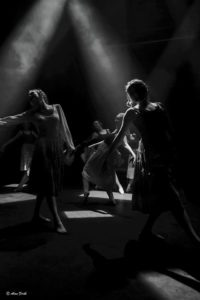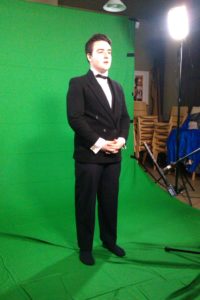
When I told the archivists at the Institute of Engineering and Technology in London that I would be writing my undergraduate thesis as a play about Britain’s Electrical Association for Women (EAW), they pointed me to a play written and performed by the EAW in 1930. The play, “Watts” in a Home, was just one manifestation of the EAW’s central mission to free housewives from “domestic drudgery” by introducing electricity into British homes. The four-act play aimed to instruct its audience in the possibilities of the new “electrical age” by dramatising the history of domestic lighting from 1880 to 1929.[1] One of the particularly exciting aspects of “Watts” in a Home was that its characters addressed concerns about electricity held by the EAW’s audience while using real electric lighting onstage.
The EAW’s decision to mirror the content of their play in its form became the foundation of my undergraduate thesis: I, too, would write about the history of electrification while paying conscious attention to the way electric lights would be used onstage.[2] My play would also address the different techniques used to reach audiences of early twentieth-century popularisation of electricity, while meta-theatrically employing the same popularisation techniques on my play’s audience.
It was a big project for a year of work. But with the indefatigable guidance of my advisor Dr. Jenna Tonn (and the rocky road of revision familiar to academics and playwrights alike), I ended up with a final project which fused the history of science and performing arts. The final version of my thesis began as an analytical paper on dramatising science, drawing from scholarship in both the history of science and performance studies. It also included two chapters on the intended audiences of the EAW’s work, as seen in their private correspondence and magazine. The final chapter was a full-length play with footnotes (titled Wire in the Garden in homage to “Watts” in a Home), which dramatized 108 letters sent between Caroline Haslett and her friend and fellow engineer, Margaret Partridge, between 1925 and 1927.[3] Wire in the Garden focused on Partridge’s difficulties in electrically lighting the rural town of Thorverton, Devon in the face of rural anxieties about electricity’s safety, appearance, and religious significance. Here are a few things I learned from the project — and why I think performance should be used more often as a tool for history of science scholarship.
![[photo] Partridge, Haslett, and apprentices standing in line.](https://pbs.twimg.com/media/Cg4V1qSWMAAbUm6.jpg)
Scripting Wire in the Garden required me to re-imagine the lives of my historical actors in intimate detail: their conversations, their physical actions, the mundane things they needed to do to get through a normal day. This meant that my research for the play needed to be both broader, and in some cases deeper, than dictated by my analytical chapters. Though I was writing about the EAW’s popularization strategies, I ended up researching things like the history of rural British Baptists,[4] and asking myself unexpected questions about the physicality of electrifying a town: how might Partridge’s power and expertise be established or challenged in the context of a team of workers, and would rural villagers see certain physical demands of electrification as more problematic than others in the context of Partridge’s femininity? These questions led me to a more nuanced understanding of who Partridge was communicating with, and how she chose to do so.
But though I’d worked hard to reconstruct the cultural landscape in which the events of the play took place, nothing showed me the oversights in my research quite like handing the script to my director and actors. After only a few hours of workshopping, my creative team sent me back to the drawing board (and archives) with questions about the play which were not only dramaturgical but also historiographical. One character was portrayed too reductively; my limited lens was clear in the script but had not been so noticeable in my analytical chapters. Actors asked me to clarify the legal and commercial aspects of Partridge’s work so that they could better understand the stakes of a scene. The director, Megan Sandberg-Zakian, told me to learn more about the layout and construction of rural power stations, and to consider how that might have affected the contents of Partridge’s letters. Their training in theatre had shown them that the holes in my research were not only key to understanding how technology, gender, and popularisation were interacting, but also needed to be filled in to make the play structurally sound.
Theatre embraces and, more importantly, acknowledges the imagination required to tell a complete story.
Theatre is mimesis, imitation, “lying in order to tell the truth.” The real bodies which interact onstage are in tension with the constructed, rehearsed nature of a play’s performance — and audiences know that they are witnessing a fictionalized version of reality. But while I was fictionalizing history in my play, I tried not to falsify it. Only three of the characters in Wire in the Garden are historical figures; the remaining four are “composite characters,” because, though they themselves are fictional, I’d created them by combining trends, stories, and language from archival and secondary sources. It was particularly interesting to see these semi-imagined characters (e.g. a young housewife) fill out perspectives on rural electrification which were missing from Partridge’s letters.
Theatre is a multi-sensory art form, and the words of the script are only the bones.
My play became much richer when I embraced the fact that not everything needed to be spoken. Instead, I could capitalize on movement, scenography, and sound in order to communicate more nuanced ideas from my research. When I recreated ambiguous images from the historical record instead of explaining them away, audiences had the opportunity to interpret the images in the context of the other information included in the play. For example, to evoke the references to Eden peppered throughout my sources, I wrote in a huge tree to dominate the stage with its trunk of wires and pendulous bulbs hanging down like fruits. The tree could be read as a symbol of technological advancement and redemption; it might also reflect the intrusion of technology into idyllic, righteous, pastoral life (a la Leo Marx); maybe it brought light and knowledge to dark places, or destroyed what was already there. Or maybe all of those things. Or maybe none. That question was left open to the audience, inviting them to reconcile differing historical (and historiographical) perspectives.
Like the fantastical visualizations of electricity in its early days (fairies, and wizards, and imps, oh my!), writing fantasy into my script became a useful tool even as I was tied to accurately representing historical sources. By incorporating fantastical elements into different styles of scenes (e.g. dreams, advertisements, presentations, letters), I was able to quote lots of material directly from my sources. I hoped that by quoting these sources directly, my audience would note both how popularisation was deployed in early-twentieth century Britain, as well as how they were receiving it as its audience. This would lead them to experientially understand popularisation as Roger Cooter and Stephen Pumfrey’s conception of “grafting, appropriation, and transformation” of ideas, instead of the more traditional (and problematic) metaphors of “dilution, […] contamination, contagion, seduction, or colonization.”[5]
Moving forward…
Dramaturgy, like history, is a rigorous craft — and just as watching and sketching are tools for biologists, I believe dramatisation can serve historians of science. In my own project, writing the play was as much a part of my methodology as secondary sourcework or peer review. It forced me to empathize with all of my historical actors, work harder to reconstruct their cultural landscape, and notice (even challenge) the assumptions I was making throughout. It was my first foray into an interdisciplinary crossroads where I hope more scholars will return.
The good news is that dramatisation is not as far from standard historical methodology as one might originally think. Historians have acknowledged the pedagogical benefits of reenacting experiments,[6] historian of science Robert Marc Friedman has written compellingly about his experiences dramatising his past research,[7] and a recent plenary at the 2015 annual meeting of the History of Science Society featured historians performing as early modern readers in mob caps. Though writing a play like Wire in the Garden is certainly not going to be the best methodological strategy for every project in the history of science, intentionality and innovation in choosing the form through which to communicate scholarship can be a productive way to shed light on parts of the history of science – like interpersonal relationships, cultural landscapes, and practitioners’ bodies – which fight against a two-dimensional rendering.
Thoughts? Would love to hear your responses in the comments below!
About the author
Alona Bach recently graduated from Harvard with a degree in History of Science and Theatre, Dance, and Media. This post is based on her thesis, “Lights Up: Performing Science and the Electrical Association for Women, 1925-1927,” which was advised by Dr. Jenna Tonn and received playwriting support from Dr. Joyce van Dyke. In the fall, Alona will begin the MPhil programme in History and Philosophy of Science at Cambridge University. She plans to continue to work as an actor and playwright, and pursue a career in museums.
Notes
[1] “EAW play, ‘Watts in a Home’,” Electrical Association for Women, item 31, series UK0108 NAEST 093/09, IET Archives. The play’s title was characteristically punny. Correspondence between EAW founder Caroline Haslett and her friend Margaret Partridge, for example, praised an EAW colleague who proposed a talk entitled “Ohm Sweet Ohm,” and Partridge often peppered her letters with puns such as: “must cease this babbling of watts & watt not.” See Haslett to Partridge, 18 May 1925, and Partridge to Haslett, 28 May 1925, Box 9, Correspondence with Margaret Partridge, Women’s Engineering Society, IET Archives.
[2] A similar technique is also used provocatively in Sarah Ruhl’s In the Next Room: Or, The Vibrator Play, which examines female sexuality in tandem with the domestication of electricity.
[3] Box 9, Correspondence with Margaret Partridge, Women’s Engineering Society, IET Archives.
[4] Partridge poked fun in her letters at a Baptist preacher who preached about “the Mysteries of Electricity,” as well as her secretary in Thorverton, “a godly man much respected in the chapel” who would “pray with the engine if it won’t run – & sing psalms to the batteries if they do gas exceedingly.” See Partridge to Haslett, 3 May 1925, Box 9, Correspondence with Margaret Partridge, Women’s Engineering Society, IET Archives.
[5] Roger Cooter and Stephen Pumfrey, “Separate Spheres and Public Places: Reflections on the History of Science Popularization and Science in Popular Culture,” History of Science 32, no. 97 Part 3 (September 1994): 249.
[6] For more on reenacting experiments, see, for example, the working group at the University of Oldenburg and Professor Pamela Smith at Columbia.
[7] Robert Marc Friedman, a historian of science who later became a playwright, argues that theatre should be used to transform episodes and figures from the history of science into “public property” belonging to a collective “cultural heritage.” Why? “Science,” he writes, “is too important a societal activity to insulate its practices, results, and consequences from public scrutiny and reflection.” Putting narratives of science into the public domain via plays invites the public to question and challenge the role of science in society. It also reveals the process and failures of science versus just its results, and thereby acts as a window into spaces previously reserved for authorities. See Robert Marc Friedman, “Balancing Act: Drama about Science Based on History,” in The SciArtist: Carl Djerassi’s Science-in-Literature in Transatlantic and Interdisciplinary Contexts, ed. Walter Grünzweig, vol. 11, Transnational and Transatlantic American Studies (Wien: Lit, 2012): 63-73.

